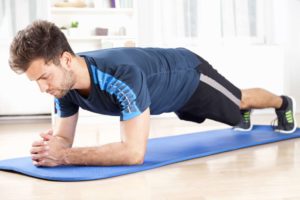Aug 1, 2022The Core Benefits of Planking
Most people have heard of planking, but there are also plenty of misconceptions about what this move entails.
Although there are lots of variations and modifications, a plank is an isometric exercise that targets the core. So if you’ve ever wanted to know how to get a stronger core (opens in new tab), you’ll find the plank figures highly.
 A recent article from LiveScience.com highlighted a conversation with physical therapist Kristina Kehoe about the benefits of planking.
A recent article from LiveScience.com highlighted a conversation with physical therapist Kristina Kehoe about the benefits of planking.
Below is an excerpt from the LiveScience.com article.
“A plank typically involves assuming a push-up type position and maintaining that position for a specific amount of time,” explains Kehoe. “There are a variety of variations of the plank that can target different areas of the core.”
The basic forearm plank is performed with your body propped up from your elbows with your forearms and toes on the ground.
The different plank variations may recruit additional muscles or add forms of resistance, instability, or movement to progress or regress a basic plank.
Kehoe says that the primary muscles activated during the plank exercise are those that make up the core(opens in new tab), such as the transverse abdominis, the rectus abdominis, and the internal and external obliques.
“The transverse abdominis is our deepest core muscle. This muscle acts as a corset and attaches to our pelvis then wrapping around our front to the lumbar spine. It helps stabilize the spine in all movements,” explains Kehoe. “The rectus abdominis is the ‘6-pack’ abs that run on the front part of our abdomen. The obliques run on the sides of our abdomen and help in overall stability.”
In addition to these abdominal muscles, planks activate other muscles of the core such as the erector spinae in the lower back, the serratus anterior in the upper back, the latissimus doors, and the glutes. Most plank exercise variations also engage the deltoids in the shoulders and pectoralis major and minor in the chest.
According to Kehoe, one of the primary benefits of the plank as a core exercise lies in its safety.
“The plank is an effective exercise because it doesn’t put a lot of compressive force on the lumbar spine like exercises such as full-sit ups or back extensions. Therefore, it’s a safer option especially if you’ve had a recent back injury,” she notes.
“Additionally, the plank exercise and variations have been shown to improve core muscle endurance, as well as stability and, are effective in improving overall core strength in pre- and post-testing with the McGill Torso Muscular Endurance Test.”
Kehoe adds that other benefits of the plank as a core exercise is that it’s a bodyweight exercise that does not require equipment and it can be modified to target different muscles or fitness levels. “There are a number of ways to progress planks to decreasing support on a surface, adding an unstable surface, or adding dynamic movement,” she says.
To read the full story from LiveScience.com and get a sample guide of planking variations, click here.


